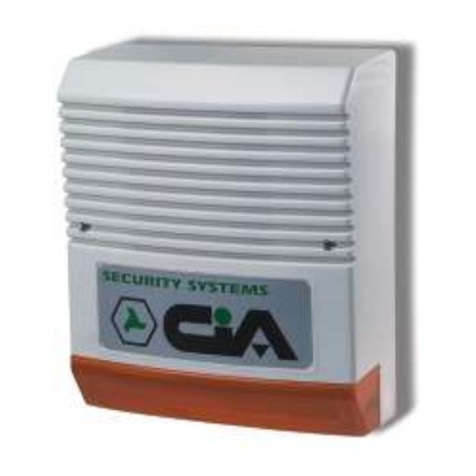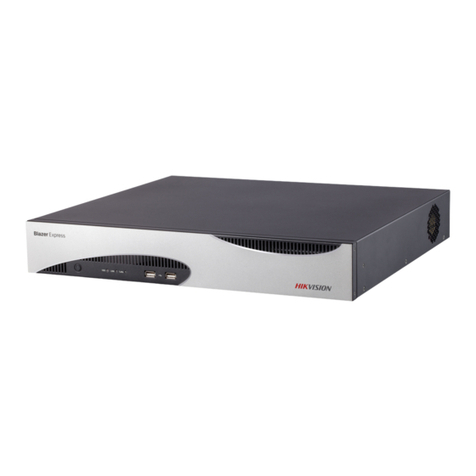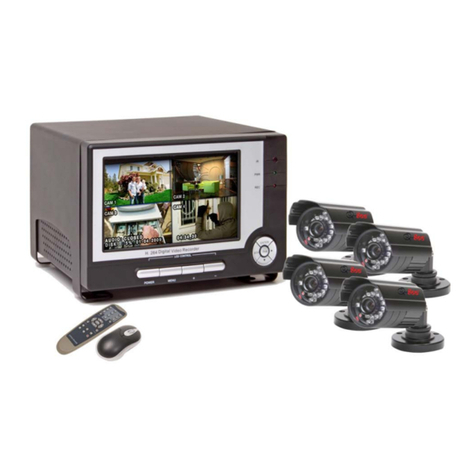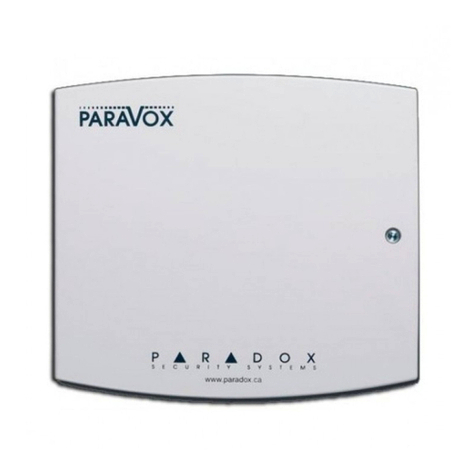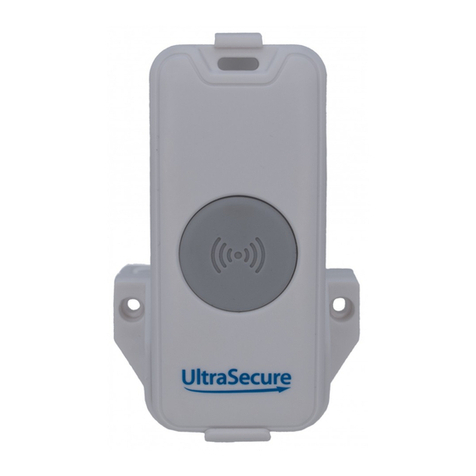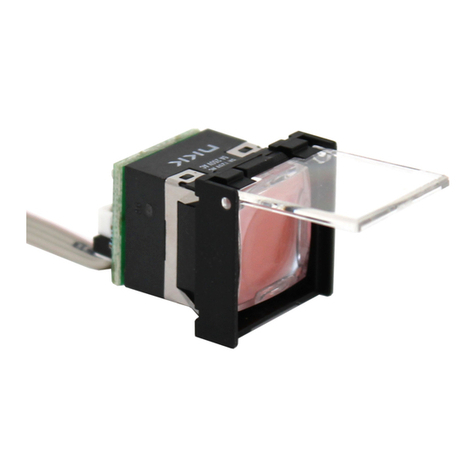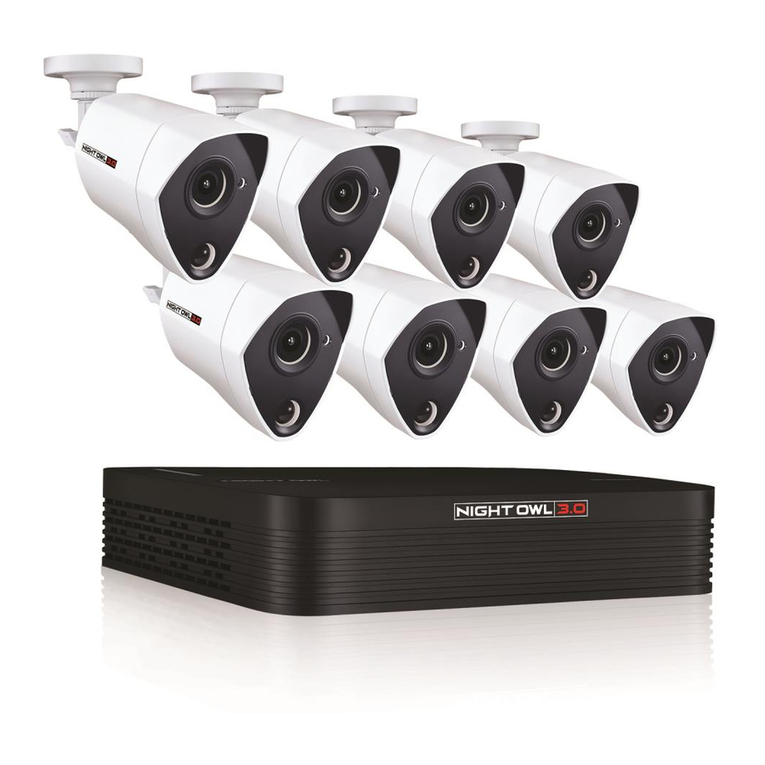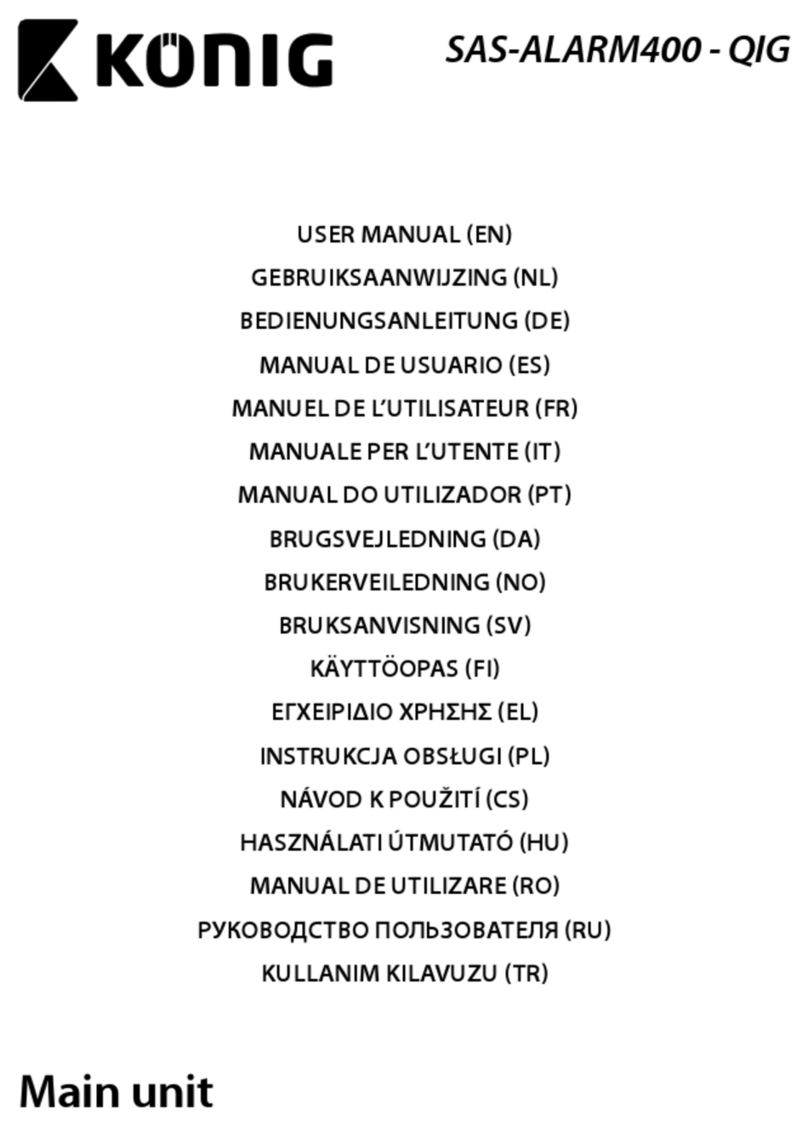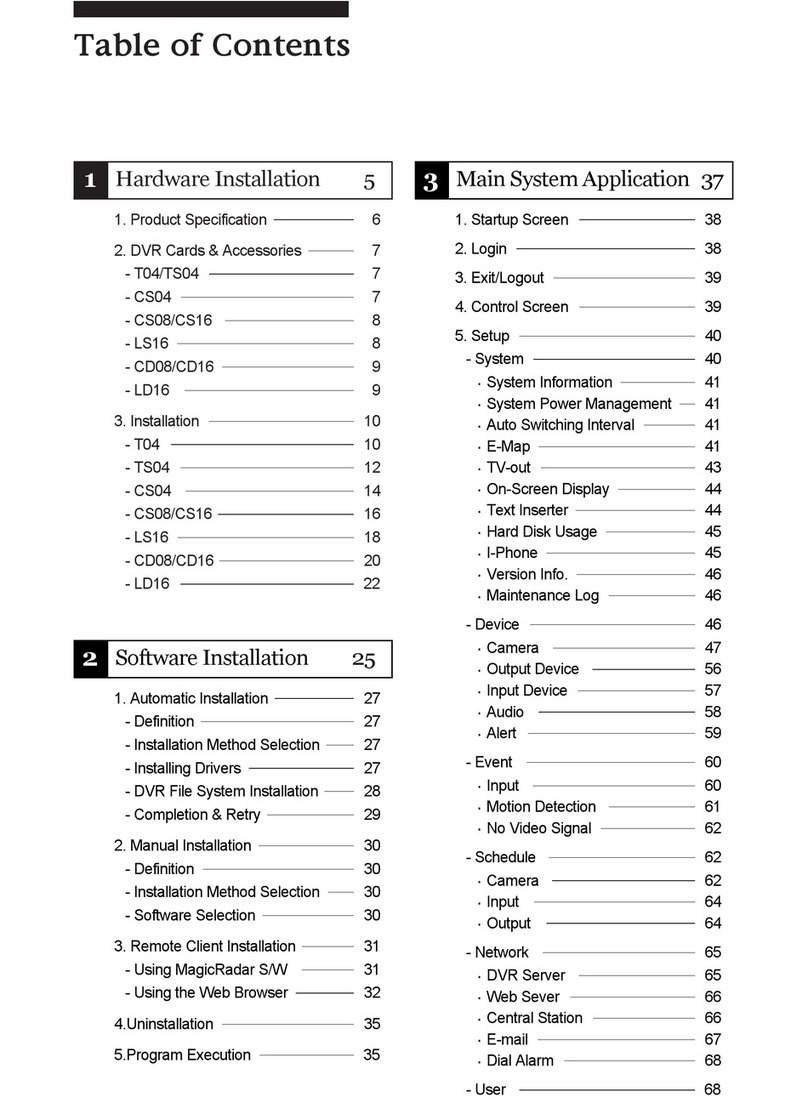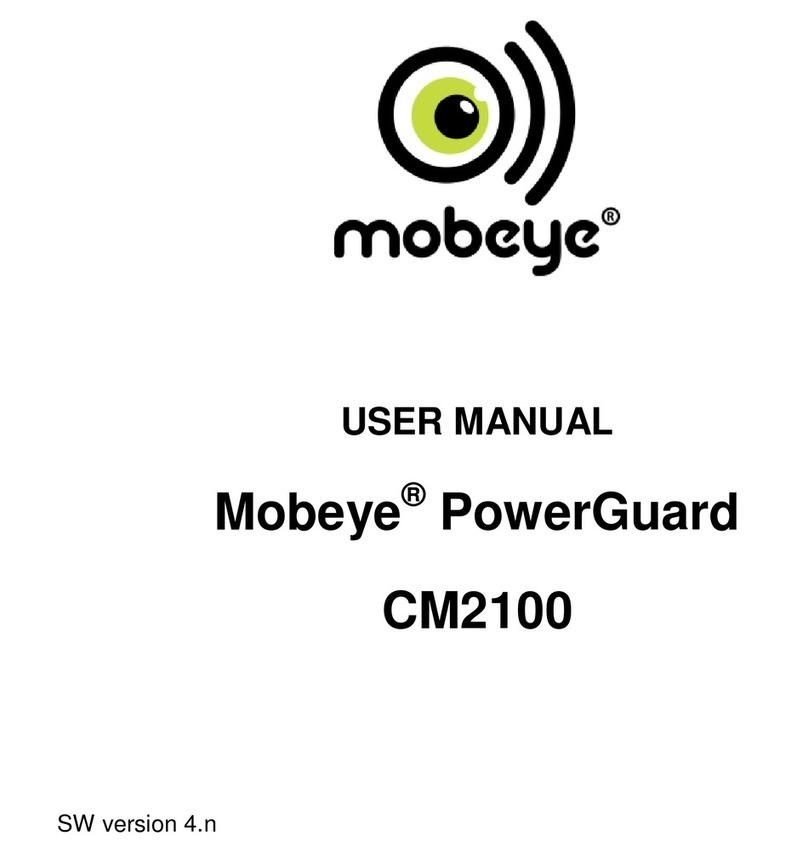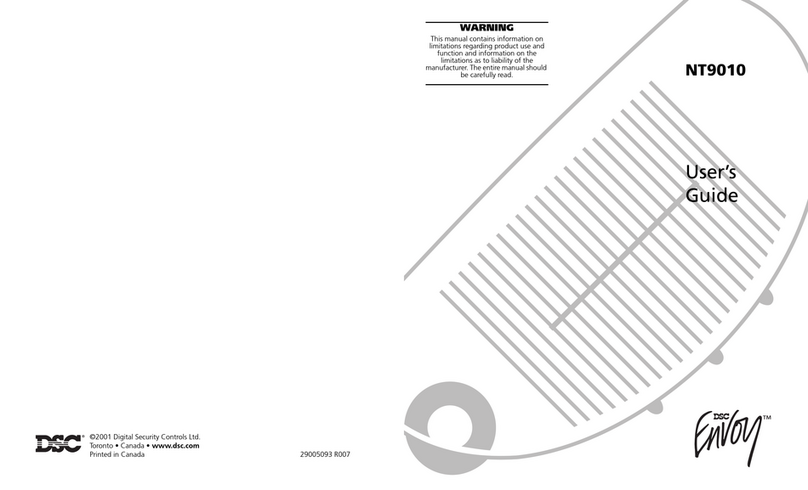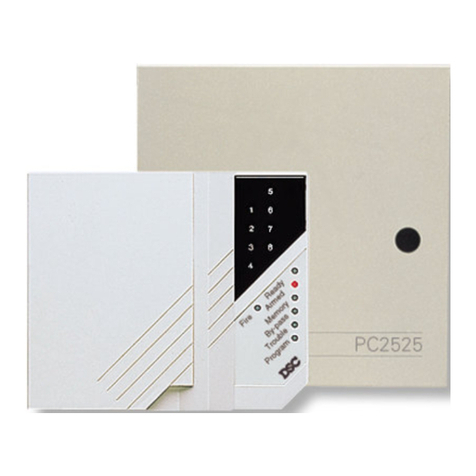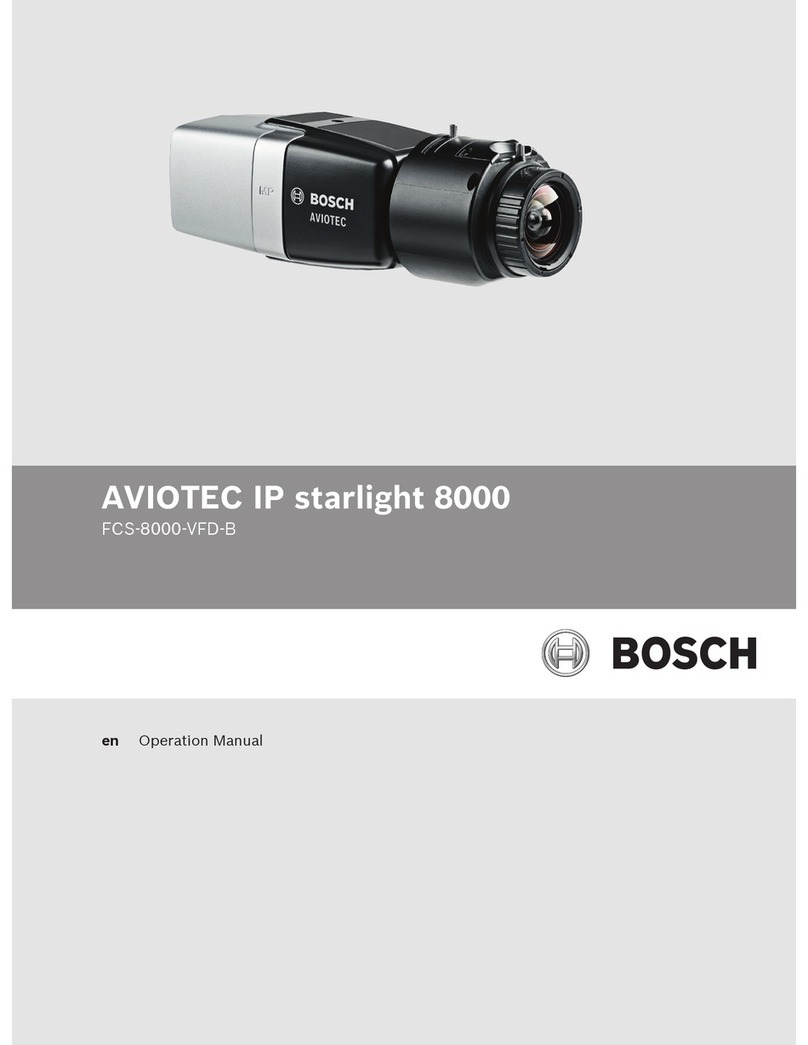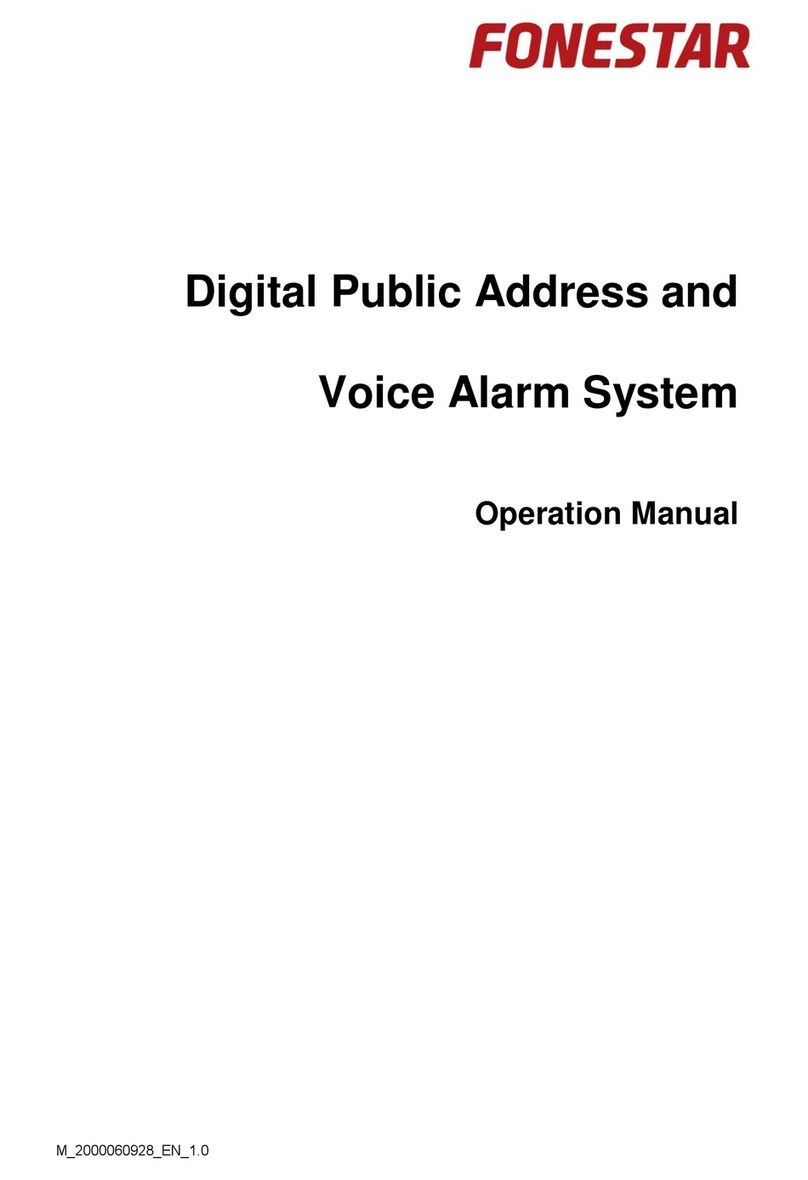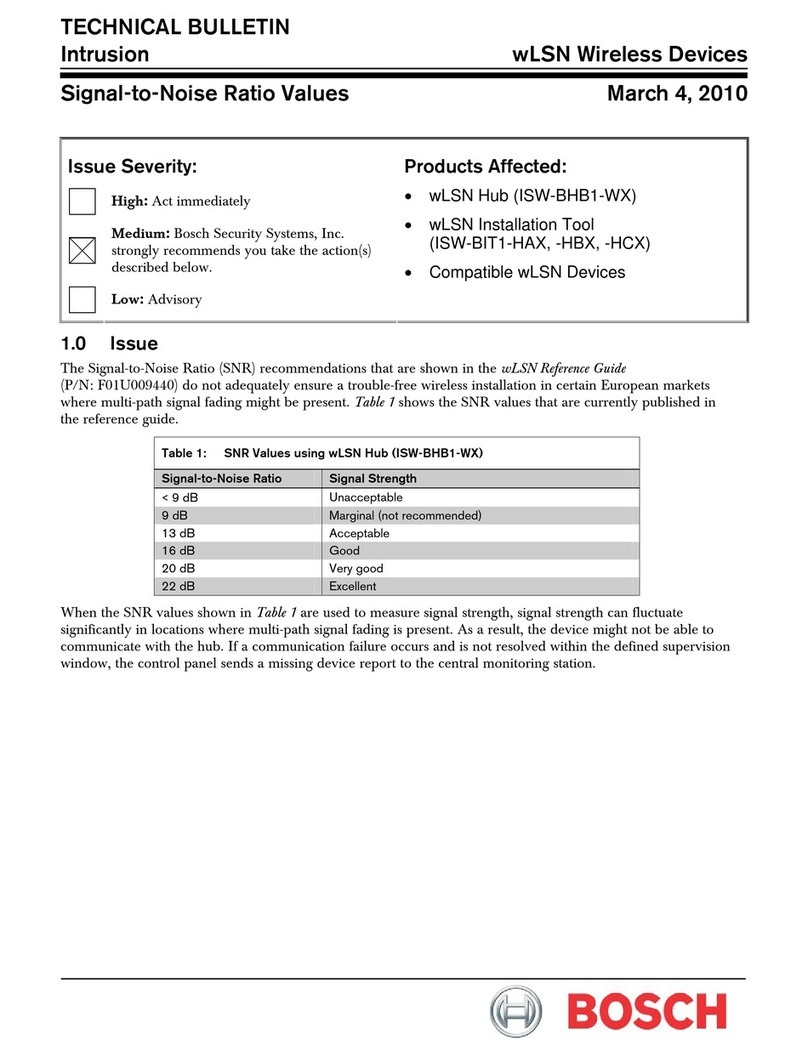CiA PROTEC4 User manual

PROTEC4
4zones burglary central unit
ITALIANO
ENGLISH
USER’S MANUAL

Index
Chapter 1 Introduction 19
1.1 Central unit description ...................................................................................................19
1.2 Operating features ..........................................................................................................19
1.3 Technical features...........................................................................................................20
Chapter 2 Installation 21
2.1 General instructions........................................................................................................21
2.2 Power supply ..................................................................................................................21
2.3 Connections....................................................................................................................22
2.3.1 Electronic key.....................................................................................................23
2.3.2 Reed contacts and volumetric detectors ............................................................24
2.3.3 Telephone dialer.................................................................................................25
2.3.4 Sirens.................................................................................................................26
Chapter 3 Programming 27
3.1 Exiting time regulation ....................................................................................................27
3.2 Entering time regulation..................................................................................................27
3.3 Alarm time regulation......................................................................................................27
Chapter 4 Operating 28
4.1 Panel description ............................................................................................................28
4.2 System enabling .............................................................................................................29
4.2.1 Enabling by the front panel key..........................................................................29
4.2.2 Enabling by other command system..................................................................29
4.3 System disabling.............................................................................................................30
4.3.1 Disabling by the front panel key.........................................................................30
4.3.2 Disabling by other command system .................................................................30
4.4 Zones exclusion..............................................................................................................30
4.5 Zones operating..............................................................................................................31
4.5.1 Zone 1 (immediated)..........................................................................................31
4.5.2 Zone 2 (immediated)..........................................................................................31
4.5.3 Zone 3 (delayed)................................................................................................31
4.5.4 Zone 24h (immediated)......................................................................................31
4.6 Alarm memory ................................................................................................................31
Chapter 5 Maintenance 32
5.1 Components to change...................................................................................................32
5.2 Cleaning..........................................................................................................................32
5.3 Fuses ...........................................................................................................................32
18 19
1 Introduction
Dear customer,
we desire thank you for buying a CIA product. We recommend us to read this manual with
attention, because it will be very useful in phase of installation and use.
As CIAcustomer you can make use of a series of services, such as the technical telephone
assistance on the CIAproducts.
1.1 Central unit description
The PROTEC4 is a burglary central unit with microprocessor technology to use on the
whole of a burglary protection system for habitation and commercial rooms of small and middle
dimensions.
It is to be used with the perimetral protection magnetic sensors, and/or with the volumetric
detectors.
The alarm can be:sounding/luminous,with the autopowered SA310 siren for outdoor use;
sounding, with the piezoelectric SP31 siren for inside use; telephonic, with the TD81 telephone
dialer.
1.2 Operating features
!
!
!
!
!
!
!
!
!
!
!
!
!
4 protection zones: (1 delayed, 2 immediate, 1 24 hours) with alarm memory.
All zones singly excludibles.
Exit timing adjustable from 5 up to 75 sec.
Entrance time from 5 up to 90 sec.
Alarm duration from 30 up to 600 sec.
Control LEDs: main voltage presence, exit timing and zone status.
Visualization of the zones state with central unit switched off.
Protection fuse on sirens voltage output and service voltage output.
Sabotage alarm for attempt to exclude zone when the central is switched on.
Output for connection for controller systems SK,KB and SCM (electronic key, electronic
keyboard and magnetic card).
"ALARM MEMORY" function for visualization of the zones that caused the alarm.
Central unit protection by intermal tamper (can be excluded for maintenance).
According to the 1° level of CEI 79-2 standard.
IntroductionPROTEC4 - User’s manual

Index
Chapter 1 Introduction 19
1.1 Central unit description ...................................................................................................19
1.2 Operating features ..........................................................................................................19
1.3 Technical features...........................................................................................................20
Chapter 2 Installation 21
2.1 General instructions........................................................................................................21
2.2 Power supply ..................................................................................................................21
2.3 Connections....................................................................................................................22
2.3.1 Electronic key.....................................................................................................23
2.3.2 Reed contacts and volumetric detectors ............................................................24
2.3.3 Telephone dialer.................................................................................................25
2.3.4 Sirens.................................................................................................................26
Chapter 3 Programming 27
3.1 Exiting time regulation ....................................................................................................27
3.2 Entering time regulation..................................................................................................27
3.3 Alarm time regulation......................................................................................................27
Chapter 4 Operating 28
4.1 Panel description ............................................................................................................28
4.2 System enabling .............................................................................................................29
4.2.1 Enabling by the front panel key..........................................................................29
4.2.2 Enabling by other command system..................................................................29
4.3 System disabling.............................................................................................................30
4.3.1 Disabling by the front panel key.........................................................................30
4.3.2 Disabling by other command system .................................................................30
4.4 Zones exclusion..............................................................................................................30
4.5 Zones operating..............................................................................................................31
4.5.1 Zone 1 (immediated)..........................................................................................31
4.5.2 Zone 2 (immediated)..........................................................................................31
4.5.3 Zone 3 (delayed)................................................................................................31
4.5.4 Zone 24h (immediated)......................................................................................31
4.6 Alarm memory ................................................................................................................31
Chapter 5 Maintenance 32
5.1 Components to change...................................................................................................32
5.2 Cleaning..........................................................................................................................32
5.3 Fuses ...........................................................................................................................32
18 19
1 Introduction
Dear customer,
we desire thank you for buying a CIA product. We recommend us to read this manual with
attention, because it will be very useful in phase of installation and use.
As CIAcustomer you can make use of a series of services, such as the technical telephone
assistance on the CIAproducts.
1.1 Central unit description
The PROTEC4 is a burglary central unit with microprocessor technology to use on the
whole of a burglary protection system for habitation and commercial rooms of small and middle
dimensions.
It is to be used with the perimetral protection magnetic sensors, and/or with the volumetric
detectors.
The alarm can be:sounding/luminous,with the autopowered SA310 siren for outdoor use;
sounding, with the piezoelectric SP31 siren for inside use; telephonic, with the TD81 telephone
dialer.
1.2 Operating features
!
!
!
!
!
!
!
!
!
!
!
!
!
4 protection zones: (1 delayed, 2 immediate, 1 24 hours) with alarm memory.
All zones singly excludibles.
Exit timing adjustable from 5 up to 75 sec.
Entrance time from 5 up to 90 sec.
Alarm duration from 30 up to 600 sec.
Control LEDs: main voltage presence, exit timing and zone status.
Visualization of the zones state with central unit switched off.
Protection fuse on sirens voltage output and service voltage output.
Sabotage alarm for attempt to exclude zone when the central is switched on.
Output for connection for controller systems SK,KB and SCM (electronic key, electronic
keyboard and magnetic card).
"ALARM MEMORY" function for visualization of the zones that caused the alarm.
Central unit protection by intermal tamper (can be excluded for maintenance).
According to the 1° level of CEI 79-2 standard.
IntroductionPROTEC4 - User’s manual

THE PRODUCT RESULTS CONFORM TO THE FOLLOWING STANDARDS REQUIREMENTS:
STND SPECIFICATION TITLE
EN50081-1 EMISSION STND
Part.1: residential, commercial and light industry
EN50082-1 IMMUNITY STND
Part.1: residential, commercial and light industry
EN60335-1 SAFETY OF HOUSEHOLD AND SIMILAR ELECTRICAL
APPLIANCES
CONFORMITY WAS BASED ON EMC PERFORMANCE TESTS CONDUCTED ON SAMPLE RUNNING IN THE
DESIGNED WORKING CONDITIONS AS FOR ITS FUNCTIONAL PROJECT, IT MEETS 89/336/EEC AND 73/23
EEC REQUIREMENTS.
DATE
21 May 1999 COMPANY MANAGEMENT
2 Installation
2.1 General instructions
!Do not install the device at places exposed to the bad weather or to the extreme
temperatures.
!The central unit is protected from the opening, but the installation in a safe place is a
greater protection of the device.
!For a strong and safe fixing, it needs making sure the wall surface is plane.
!Fixing the device by the four fishers included in the central unit and no replacing them with
others of more small size.
!Fixing the central unit at a height that allows an easy access to the frontal panel.
!The central unit must be connected with an alarm system according to CEI 79-3 Standard
or similar.
2.2 Power supply
It ‘s important to know that the entire system is powered exclusively by the 12V 7,5Ah lead
battery inside of the burglary central unit; the lead battery is constantly in charge by the AL5
power supplier/battery connected to the 230V~ main power supply.
20
1.3 Technical features
!Operating voltage: 230V~ ±10% 50Hz
!Maximum current absorption: 140mA
!Service output voltage:
!Maximum current supplied on services output: 650mA
!Fuse on services output voltage F type 1A
!Maximum current supplied on sirens output 3A(connected to the battery)
!Sirens output fuse: Tipo F 3,15A
!Maximum current supplied by power supplierAL5: 1A
!Min operating temperature: 5±2°C
!Max operating temperature: 40±2°C (relative humidity. 93±2%)
!Box protection level: IP30
!Buffer battery: 12V7Ah
!Fuse on primary of the power supply: F type 250mA
!Fuse on secondary of the power supply: F type 1A
!Central unit dimensions: 280x230x95mm
!Insulation class:
!
13V!±5%
Prestation level: 1°
21
HiLTRON
S.r.l.
®
PROGETTAZIONE E PRODUZIONE APPARECCHIATURE ELETTRONICHE
PROTEC4 - User’s manual Installation
CONSTRUCTOR: HiLTRON S.r.l.
ADDRESS: Circ. Est. di Napoli compls. Lemar 80026 Casoria (NA)
TRADE MARK:
PRODUCT CODE: PROTEC4
PRODUCT DESCRIPTION: 4 ZONES BURGLARY CENTRAL UNIT
DECLARATION OF CONFORMITY
230V~
50Hz
main power supply
Switch
WARNING!
The main power supply 230Vac has to be connected to the power supplier/battery
charger AL5 by two 1,5mm² double-isolation wires coming from a sectioning switch(i.e.
a magneto-thermic protection switch) used exclusively for the burglary central unit.
Inside of the central unit positioning orderly the two wires, locking them by wrappers.

THE PRODUCT RESULTS CONFORM TO THE FOLLOWING STANDARDS REQUIREMENTS:
STND SPECIFICATION TITLE
EN50081-1 EMISSION STND
Part.1: residential, commercial and light industry
EN50082-1 IMMUNITY STND
Part.1: residential, commercial and light industry
EN60335-1 SAFETY OF HOUSEHOLD AND SIMILAR ELECTRICAL
APPLIANCES
CONFORMITY WAS BASED ON EMC PERFORMANCE TESTS CONDUCTED ON SAMPLE RUNNING IN THE
DESIGNED WORKING CONDITIONS AS FOR ITS FUNCTIONAL PROJECT, IT MEETS 89/336/EEC AND 73/23
EEC REQUIREMENTS.
DATE
21 May 1999 COMPANY MANAGEMENT
2 Installation
2.1 General instructions
!Do not install the device at places exposed to the bad weather or to the extreme
temperatures.
!The central unit is protected from the opening, but the installation in a safe place is a
greater protection of the device.
!For a strong and safe fixing, it needs making sure the wall surface is plane.
!Fixing the device by the four fishers included in the central unit and no replacing them with
others of more small size.
!Fixing the central unit at a height that allows an easy access to the frontal panel.
!The central unit must be connected with an alarm system according to CEI 79-3 Standard
or similar.
2.2 Power supply
It ‘s important to know that the entire system is powered exclusively by the 12V 7,5Ah lead
battery inside of the burglary central unit; the lead battery is constantly in charge by the AL5
power supplier/battery connected to the 230V~ main power supply.
20
1.3 Technical features
!Operating voltage: 230V~ ±10% 50Hz
!Maximum current absorption: 140mA
!Service output voltage:
!Maximum current supplied on services output: 650mA
!Fuse on services output voltage F type 1A
!Maximum current supplied on sirens output 3A(connected to the battery)
!Sirens output fuse: Tipo F 3,15A
!Maximum current supplied by power supplierAL5: 1A
!Min operating temperature: 5±2°C
!Max operating temperature: 40±2°C (relative humidity. 93±2%)
!Box protection level: IP30
!Buffer battery: 12V7Ah
!Fuse on primary of the power supply: F type 250mA
!Fuse on secondary of the power supply: F type 1A
!Central unit dimensions: 280x230x95mm
!Insulation class:
!
13V!±5%
Prestation level: 1°
21
HiLTRON
S.r.l.
®
PROGETTAZIONE E PRODUZIONE APPARECCHIATURE ELETTRONICHE
PROTEC4 - User’s manual Installation
CONSTRUCTOR: HiLTRON S.r.l.
ADDRESS: Circ. Est. di Napoli compls. Lemar 80026 Casoria (NA)
TRADE MARK:
PRODUCT CODE: PROTEC4
PRODUCT DESCRIPTION: 4 ZONES BURGLARY CENTRAL UNIT
DECLARATION OF CONFORMITY
230V~
50Hz
main power supply
Switch
WARNING!
The main power supply 230Vac has to be connected to the power supplier/battery
charger AL5 by two 1,5mm² double-isolation wires coming from a sectioning switch(i.e.
a magneto-thermic protection switch) used exclusively for the burglary central unit.
Inside of the central unit positioning orderly the two wires, locking them by wrappers.

2.3.1 Electronic key
* This connection will activate the 24h anti-sabotage protection alarm when a false key is
inserted in the SKI connector.
When the installation is finished, it needs to connect the red/black conductors equipped
with faston coming from the AL5 power supplier to the battery. Be careful about connection
polarity (Red=positive [+] of the battery; Black=negative [-] of the battery), so that no cause
great damages to the connected devices.
After connecting the central unit and the siren batteries, it’s possible to power on the
system by the sectioning switch connected on the AL5. The “RETE” LED signals the effective
presence of the main voltage.
13Vcc output tension on system enabled for the telephone dialer enabling.
13Vcc regular output tension for volumetric detectors, telephone dialer, etc.
ATTENTION! Maximun current supplied: 650mA
13Vcc output tension to recharge the autopowered siren. In alarm condition this
tension falls.
13Vcc output tension in alarm condition for supplementary indoor sirens and
telephone dialer activation.
13Vcc output tension PX, SK or KB command systems.
(10) = red LED
(11) = green LED
13 NC* line (immediated).
NC* line (immediated).
NC* line (immediated).
12 - 16 NC* line (delayed).
* If the alarm zones are not used, the clamps must be arched.
The PROTEC4 and the AL5 don’t need the ground connection, but for safety reasons and
for the respect of the laws in vigor we suggest to make and test a ground connection for the all
devices that need it.
2.3 Connections
1 - 2 Output in series to the key switch of the front panel. Cut to connect PX, SK or KB
command systems.
3 - 4
5 - 6
7 - 8
8 - 9
10 - 11 to command the LED on
12 - 24h anti-sabotage protection zone
12 - 14 Zone 1
12 - 15 Zone 2
Zone 3
22 23
InstallationPROTEC4 - User’s manual
ATTENTION!
The 12V7Ah battery must always be connected. Ensure of its efficient charge state,
measuring the tension by a volt-meter, after disconnecting the main power supply from
the AL5 power supplier/battery charger by the sectioning switch. Also in case of
changing of the lead battery it’s necessary to disconnect the main power supply from
the AL5 power supplier/battery charger, to avoid that the entire system burden on it.
Don’t connect on 13Vcc services power supply output of the central unit (clamps [5] and
[6] "+12V") a load beyond 650mA.
1 2 345678 9 10 11 12 13 14 15 16
In series to
the 24h line
ATTENTION!
Optional
connection*
A
B
C
D
SKI
SK100
Remove
the arch

2.3.1 Electronic key
* This connection will activate the 24h anti-sabotage protection alarm when a false key is
inserted in the SKI connector.
When the installation is finished, it needs to connect the red/black conductors equipped
with faston coming from the AL5 power supplier to the battery. Be careful about connection
polarity (Red=positive [+] of the battery; Black=negative [-] of the battery), so that no cause
great damages to the connected devices.
After connecting the central unit and the siren batteries, it’s possible to power on the
system by the sectioning switch connected on the AL5. The “RETE” LED signals the effective
presence of the main voltage.
13Vcc output tension on system enabled for the telephone dialer enabling.
13Vcc regular output tension for volumetric detectors, telephone dialer, etc.
ATTENTION! Maximun current supplied: 650mA
13Vcc output tension to recharge the autopowered siren. In alarm condition this
tension falls.
13Vcc output tension in alarm condition for supplementary indoor sirens and
telephone dialer activation.
13Vcc output tension PX, SK or KB command systems.
(10) = red LED
(11) = green LED
13 NC* line (immediated).
NC* line (immediated).
NC* line (immediated).
12 - 16 NC* line (delayed).
* If the alarm zones are not used, the clamps must be arched.
The PROTEC4 and the AL5 don’t need the ground connection, but for safety reasons and
for the respect of the laws in vigor we suggest to make and test a ground connection for the all
devices that need it.
2.3 Connections
1 - 2 Output in series to the key switch of the front panel. Cut to connect PX, SK or KB
command systems.
3 - 4
5 - 6
7 - 8
8 - 9
10 - 11 to command the LED on
12 - 24h anti-sabotage protection zone
12 - 14 Zone 1
12 - 15 Zone 2
Zone 3
22 23
InstallationPROTEC4 - User’s manual
ATTENTION!
The 12V7Ah battery must always be connected. Ensure of its efficient charge state,
measuring the tension by a volt-meter, after disconnecting the main power supply from
the AL5 power supplier/battery charger by the sectioning switch. Also in case of
changing of the lead battery it’s necessary to disconnect the main power supply from
the AL5 power supplier/battery charger, to avoid that the entire system burden on it.
Don’t connect on 13Vcc services power supply output of the central unit (clamps [5] and
[6] "+12V") a load beyond 650mA.
1 2 345678 9 10 11 12 13 14 15 16
In series to
the 24h line
ATTENTION!
Optional
connection*
A
B
C
D
SKI
SK100
Remove
the arch

4S
4S
C451
C401/P
2B4
PG12
2.3.2 Reed contacts and volumetric detectors
ATTENTION!
The PROTEC4 doesn’t allow the connection of the ‘switch’ contacts for rolling
shutters type C778 directly on the terminal boards becouse this central unit hasn’t got
an impulse counter.
Use the SCHSW impulse counter board to connect the ‘switch’ contact for rolling shutters
type C778, or use the ‘switch’ contact for rolling shutters C800 with integrated impulse counter
for the direct connection to this central unit.
24 25
2.3.3 Telephone dialer
Phone
line
TD81
2B4
In series to
the 24h line
PROTEC4 - User’s manual Installation
Long wires
Long wires
Short wires
Short wires
In series to
the 24h line

4S
4S
C451
C401/P
2B4
PG12
2.3.2 Reed contacts and volumetric detectors
ATTENTION!
The PROTEC4 doesn’t allow the connection of the ‘switch’ contacts for rolling
shutters type C778 directly on the terminal boards becouse this central unit hasn’t got
an impulse counter.
Use the SCHSW impulse counter board to connect the ‘switch’ contact for rolling shutters
type C778, or use the ‘switch’ contact for rolling shutters C800 with integrated impulse counter
for the direct connection to this central unit.
24 25
2.3.3 Telephone dialer
Phone
line
TD81
2B4
In series to
the 24h line
PROTEC4 - User’s manual Installation
Long wires
Long wires
Short wires
Short wires
In series to
the 24h line

26 27
2.3.4 Sirens
SP31
SA310
2B2
2B2
In series to
the 24h line
3 Programmation
3.1 Exiting time regulation
The exiting time allows the system user to leave the protected zones after the system
enabling. During this time a possible activation of the sensors of the all protection zones
doesn’t activate alarms.
This timing is adjustable from 5 to 75 seconds by the trimmer situated inside of the central
unit (see picture below).
The exiting time is signalled by the flashing of the green LED “USCITA” situated on the
front panel of the central unit.
3.2 Entering time regulation
The entering time allows the system user to access the protected environments and reach
the central unit to disable the system. During this time, a possible activation of the sensors
installed on the zone 1 doesn’t activate an alarm cycle.
This timing is adjustable from 5 to 90 seconds by the trimmer situated inside of the central
unit (see picture below).
If an electronic key or any command system is installed externally to the protected
environments it’s advisable to adjust to minimum this timing.
3.3 Alarm time regulation
The alarm time duration is adjustable from 30 seconds to 10 minutes by the trimmer
situated inside of the central unit (see picture below).
Exiting time Entering time Alarm time
PROTEC4 - User’s manual Programmation

26 27
2.3.4 Sirens
SP31
SA310
2B2
2B2
In series to
the 24h line
3 Programmation
3.1 Exiting time regulation
The exiting time allows the system user to leave the protected zones after the system
enabling. During this time a possible activation of the sensors of the all protection zones
doesn’t activate alarms.
This timing is adjustable from 5 to 75 seconds by the trimmer situated inside of the central
unit (see picture below).
The exiting time is signalled by the flashing of the green LED “USCITA” situated on the
front panel of the central unit.
3.2 Entering time regulation
The entering time allows the system user to access the protected environments and reach
the central unit to disable the system. During this time, a possible activation of the sensors
installed on the zone 1 doesn’t activate an alarm cycle.
This timing is adjustable from 5 to 90 seconds by the trimmer situated inside of the central
unit (see picture below).
If an electronic key or any command system is installed externally to the protected
environments it’s advisable to adjust to minimum this timing.
3.3 Alarm time regulation
The alarm time duration is adjustable from 30 seconds to 10 minutes by the trimmer
situated inside of the central unit (see picture below).
Exiting time Entering time Alarm time
PROTEC4 - User’s manual Programmation

28 29
4 Operating
4.1 Front panel description
4.2 System enabling
4.2.1 Enabling by the front panel key switch
!Verify that the zone status LEDs and are turned off.
If they’re switched on it’s necessary to close the doors and windows relative to the zone
signalled opened. It’s also possible that the zone signalled opened could be the one
relative to the volumetric detectors; in this case the exiting time will allow to exit the
protected area without activating the alarm.
!Turn the key switch in the “ON” position.
!The green LED “USCITA” starts blinking indicating the exiting time, in which to leave the
protected areas.
!When the exiting time is finished, the green LED "USCITA" turns off indicating that the
system is enabled.
4.2.2 Enabling by other command system
If an electronic key system, a proximity key system, or an electronic keypad system is
installed outside of the protected areas, it's necessary to leave the key switch ALWAYS in the
“ON” position.
All the SKI connector for the electronic
key, the PXR reader for the proximity key
and the KBC, KBM and KBT keypads have
two LEDs, one green and one red,
indicating the central unit status (see table
beside).
To enable the system:
!Verify that the red LED is turned off.
If it's turned on, it's necessary to close
the opened doors or windows relative
to the zone that is signalled opened in
the central unit.
!Insert the electronic key, or approach
the proximity key to the reader, or digit
the code on the keypad.
!The green LED turns off indicating that
the system is enabled.
3 4
1
8
8
1
PROTEC4 - User’s manual Operating
GREEN
LED
RED
LED
BOTH
ON
System
disabled
Opened
zone/s
Alarm
memory
OFF
System
enabled
Closed
zones
FLASH
System
disabled
Excluded zone
Exiting
time
47
58
3
1 2 9
10
6
1112
Key switch
Allows to enable / disable the system. If there's
an electronic key or another command system ,
this switch has always to be turned on the
“INSERITO” position.
"RETE" red LED
on presence of main supply
off absence of main supply
"ALLARME" yellow LED
on during the entering time
or in alarm condition
blinking ALARM MEMORY
"USCITA" green LED
on system disabled
blinking during the exiting time
off system enabled
"MEMORIAALLARME" button
pressed ALARM MEMORY
visualization
released zone status
visualization
On system disabled, by pressing this button, the
blinking zones status control LEDs , e
indicate the ALARM MEMORY (i.e. the zone
that caused the alarm).
24h zone status control LED
on zona aperta
off zona chiusa
blinking zona autoesclusa
Zone1, zone 2, zone 3 status control LED
on zona aperta
off zona chiusa
*blinking ALARM MEMORY
* with the button pressed.
Zones exclusion/inclusion buttons
On system disabled, it is possible to exclude a
zone by pressing the relative button; the LED
upstanding the button starts blinking. The zone
protection willnot be included during the system
enabling.
7 8 9
5
10
11
12
1
2
3
4
5
6
7
8
9
GREEN
LED RED
LED

28 29
4 Operating
4.1 Front panel description
4.2 System enabling
4.2.1 Enabling by the front panel key switch
!Verify that the zone status LEDs and are turned off.
If they’re switched on it’s necessary to close the doors and windows relative to the zone
signalled opened. It’s also possible that the zone signalled opened could be the one
relative to the volumetric detectors; in this case the exiting time will allow to exit the
protected area without activating the alarm.
!Turn the key switch in the “ON” position.
!The green LED “USCITA” starts blinking indicating the exiting time, in which to leave the
protected areas.
!When the exiting time is finished, the green LED "USCITA" turns off indicating that the
system is enabled.
4.2.2 Enabling by other command system
If an electronic key system, a proximity key system, or an electronic keypad system is
installed outside of the protected areas, it's necessary to leave the key switch ALWAYS in the
“ON” position.
All the SKI connector for the electronic
key, the PXR reader for the proximity key
and the KBC, KBM and KBT keypads have
two LEDs, one green and one red,
indicating the central unit status (see table
beside).
To enable the system:
!Verify that the red LED is turned off.
If it's turned on, it's necessary to close
the opened doors or windows relative
to the zone that is signalled opened in
the central unit.
!Insert the electronic key, or approach
the proximity key to the reader, or digit
the code on the keypad.
!The green LED turns off indicating that
the system is enabled.
3 4
1
8
8
1
PROTEC4 - User’s manual Operating
GREEN
LED
RED
LED
BOTH
ON
System
disabled
Opened
zone/s
Alarm
memory
OFF
System
enabled
Closed
zones
FLASH
System
disabled
Excluded zone
Exiting
time
47
58
3
1 2 9
10
6
1112
Key switch
Allows to enable / disable the system. If there's
an electronic key or another command system ,
this switch has always to be turned on the
“INSERITO” position.
"RETE" red LED
on presence of main supply
off absence of main supply
"ALLARME" yellow LED
on during the entering time
or in alarm condition
blinking ALARM MEMORY
"USCITA" green LED
on system disabled
blinking during the exiting time
off system enabled
"MEMORIAALLARME" button
pressed ALARM MEMORY
visualization
released zone status
visualization
On system disabled, by pressing this button, the
blinking zones status control LEDs , e
indicate the ALARM MEMORY (i.e. the zone
that caused the alarm).
24h zone status control LED
on zona aperta
off zona chiusa
blinking zona autoesclusa
Zone1, zone 2, zone 3 status control LED
on zona aperta
off zona chiusa
*blinking ALARM MEMORY
* with the button pressed.
Zones exclusion/inclusion buttons
On system disabled, it is possible to exclude a
zone by pressing the relative button; the LED
upstanding the button starts blinking. The zone
protection willnot be included during the system
enabling.
7 8 9
5
10
11
12
1
2
3
4
5
6
7
8
9
GREEN
LED RED
LED

30 31
Operating
4.3 System disabling
4.3.1 Disabling by the front panel key switch
!Open the entering door.
!The yellow LED “ALLARME” starts blinking.
The alarm will not activates immediately becouse the entering door is usually protected by
the delayed zone 1: the entering time will allows to reach the central unit to disable the
system.
!Turn the key switch in the “DISINSERITO” position.
4.3.2 Disabling by other command system
If an electronic key system, a proximity key system, or an electronic keypad system is
installed outside of the protected areas, it's necessary to leave the key switch ALWAYS in the
“INSERITO” position.
All the SKI connector for the electronic
key, the PXR reader for the proximity key
and the KBC, KBM and KBT keypads have
two LEDs, one green and one red,
indicating the central unit status (see table
beside).
To disable the system:
!Verify that the red LED is turned off.
If it's blinking, it means that an alarm
was happened, precisely on the zone
signalled in the central unit with the
zone status LED blinking, after having
pressed the “MEMORIAALLARME"
button.
!Insert the electronic key, or approach
the proximity key to the reader, or digit
the code on the keypad.
!The green LED turns on (or blinks, if
there's an excluded zone) indicating
that the system is disabled.
3
1
1
5
4.4 Zones exclusion
From the front panel it is possible to exclude the zones 1, 2 and 3 simply by pressing the
zone related exclusion button. The exclusion of the zone is visualized by the flash of the zone
related LED.
4.5 Zones operating
The four protection zones have different operating characteristics.
4.5.1 Zone 1 (immediated)
!On system enabled, the opening of the NC line immediately activates an alarm cycle.
!The alarm is active for the alarm time setted (par. 3.3).
!This zone is excludible from the front panel.
4.5.2 Zone 2 (immediated)
!On system enabled, the opening of the NC line immediately activates an alarm cycle.
!The alarm is active for the alarm time setted (par. 3.3).
!This zone is excludible from the front panel.
4.5.3 Zone 3 (delayed)
!On system enabled, the opening of the NC line activates an alarm cycle after the entering
time setted (par. 3.2).
!The alarm is active for the alarm time setted (par. 3.3).
!This zone is excludible from the front panel.
4.5.4 Zone 24h (immediated)
!On system disabled, the opening of the NC circuit activates immediately an alarm cycle of
few seconds, then the zone autoexcludes till the line is opened.
!On system enabled, the opening of the NC circuit activates immediately an alarm cycle.
!The alarm cycle is active for the alarm time setted (par. 3.3).
4.6 Alarm memory
On system disabled, pressing the "MEMORIA ALLARME" key, the zone control LEDs
indicate the zone that caused the previous alarm.
PROTEC4 - User’s manual
GREEN
LED
RED
LED
BOTH
ON
System
disabled
Opened
zone/s
Alarm
memory
OFF
System
enabled
Closed
zones
FLASH
System
disabled
Excluded zone
Exiting
time
GREEN
LED RED
LED

30 31
Operating
4.3 System disabling
4.3.1 Disabling by the front panel key switch
!Open the entering door.
!The yellow LED “ALLARME” starts blinking.
The alarm will not activates immediately becouse the entering door is usually protected by
the delayed zone 1: the entering time will allows to reach the central unit to disable the
system.
!Turn the key switch in the “DISINSERITO” position.
4.3.2 Disabling by other command system
If an electronic key system, a proximity key system, or an electronic keypad system is
installed outside of the protected areas, it's necessary to leave the key switch ALWAYS in the
“INSERITO” position.
All the SKI connector for the electronic
key, the PXR reader for the proximity key
and the KBC, KBM and KBT keypads have
two LEDs, one green and one red,
indicating the central unit status (see table
beside).
To disable the system:
!Verify that the red LED is turned off.
If it's blinking, it means that an alarm
was happened, precisely on the zone
signalled in the central unit with the
zone status LED blinking, after having
pressed the “MEMORIAALLARME"
button.
!Insert the electronic key, or approach
the proximity key to the reader, or digit
the code on the keypad.
!The green LED turns on (or blinks, if
there's an excluded zone) indicating
that the system is disabled.
3
1
1
5
4.4 Zones exclusion
From the front panel it is possible to exclude the zones 1, 2 and 3 simply by pressing the
zone related exclusion button. The exclusion of the zone is visualized by the flash of the zone
related LED.
4.5 Zones operating
The four protection zones have different operating characteristics.
4.5.1 Zone 1 (immediated)
!On system enabled, the opening of the NC line immediately activates an alarm cycle.
!The alarm is active for the alarm time setted (par. 3.3).
!This zone is excludible from the front panel.
4.5.2 Zone 2 (immediated)
!On system enabled, the opening of the NC line immediately activates an alarm cycle.
!The alarm is active for the alarm time setted (par. 3.3).
!This zone is excludible from the front panel.
4.5.3 Zone 3 (delayed)
!On system enabled, the opening of the NC line activates an alarm cycle after the entering
time setted (par. 3.2).
!The alarm is active for the alarm time setted (par. 3.3).
!This zone is excludible from the front panel.
4.5.4 Zone 24h (immediated)
!On system disabled, the opening of the NC circuit activates immediately an alarm cycle of
few seconds, then the zone autoexcludes till the line is opened.
!On system enabled, the opening of the NC circuit activates immediately an alarm cycle.
!The alarm cycle is active for the alarm time setted (par. 3.3).
4.6 Alarm memory
On system disabled, pressing the "MEMORIA ALLARME" key, the zone control LEDs
indicate the zone that caused the previous alarm.
PROTEC4 - User’s manual
GREEN
LED
RED
LED
BOTH
ON
System
disabled
Opened
zone/s
Alarm
memory
OFF
System
enabled
Closed
zones
FLASH
System
disabled
Excluded zone
Exiting
time
GREEN
LED RED
LED

32 299ADE-1.01
5 Maintenance
5.1 Battery
5.2 Cleaning
It is advisable to check the battery connected to the AL5 power supplier/battery charger
and the battery inside of the self-powered sirens.
For the central unit cleaning, use only a soft and humid cloth.
No use absolutely diluents and abrasive sponges.
5.3 Fuses
F1 Sirens output F type 3A
F2 Services output F type 1A
PROTEC4 - User’s manual
Table of contents
Other CiA Security System manuals
